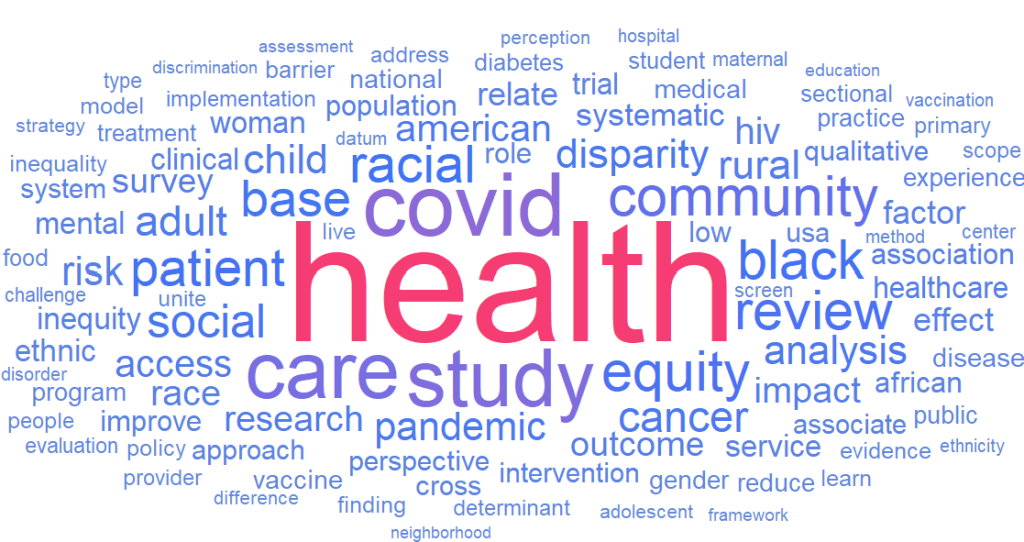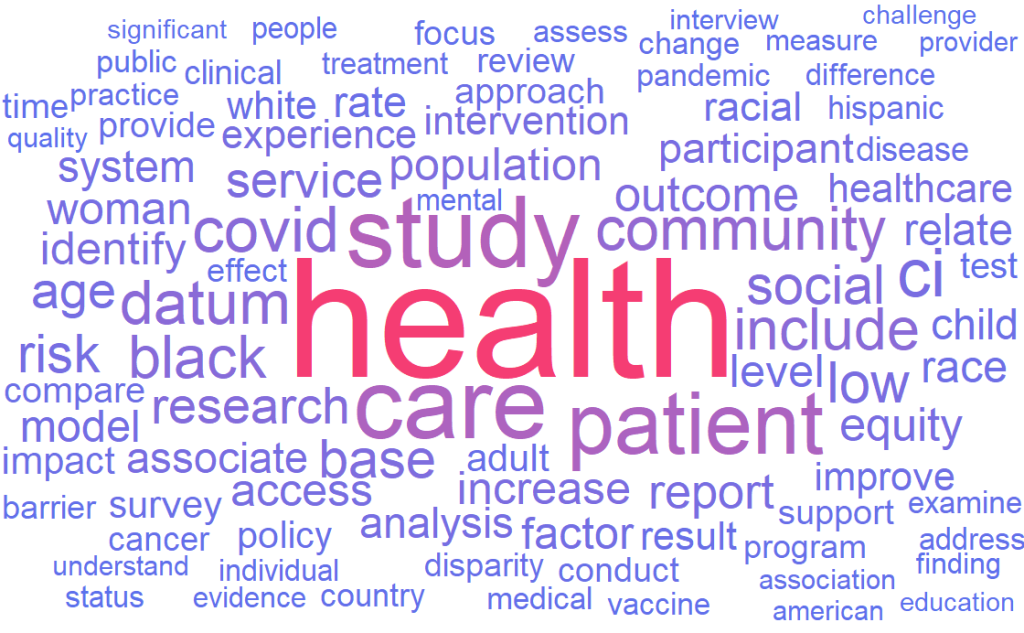A long time ago, on the other site, I used to do these monthly recaps of trends and themes in the published literature on specific topics. I got away from that, but someone recently asked me if I could do an updated analysis for them. With that prompt, it seemed like a good reason to jump back in.
If you’re reading this, you probably are interested in health equity, at least in passing. Health equity refers to the principle that every individual should have the opportunity to achieve their highest level of health, regardless of race, ethnicity, gender, socioeconomic status, or other social determinants of health. Health equity means everyone has a fair and just opportunity to access the resources they need to lead a healthy life, including quality healthcare, healthy food, safe housing, clean air and water, and other social, economic, and environmental factors influencing health.
Health equity also involves addressing the root causes of health inequities, such as systemic racism, discrimination, and social injustice, and working to eliminate these barriers to health for all individuals and communities. Ultimately, health equity ensures everyone has the same opportunities to achieve and maintain good health, regardless of background or circumstances.
This continues to be a huge topic and huge focus on research. To provide a recap of the research, I searched across six journals (International Journal for Equity in Health, The Journal of Equity in Health, Health Equity, Journal of Health Disparities Research and Practice, Journal of Racial and Ethnic Health Disparities, Diversity and Equality in Health and Care) and the term health equity to pull everything I could find over the last six month. This yielded 690 articles. A little too much to read!
Some Initial Themes
To begin with, I would like to provide a summary of all the article titles. But before delving into the major trends and themes that I discovered, I created a word cloud that displays the most frequently used words in the titles. This gives a bird’s eye view of the topics over the past six months.
You may wonder why I focused on the titles instead of the abstracts. Previously, I would analyze the abstracts to better understand the research being conducted. However, I realized that this method could place too much emphasis on the research methods and disregard other crucial aspects, such as the research context and outcomes.

As a comparison, I then did the same analysis looking at the abstracts. We can see more of the words consistent with results sections here, like significance, participation, difference, and CI.

Topics in the text
I then used a correlated topic model to group the articles based on their content and themes. With this approach, I could spot the most common and logical topics from the articles. I made sure the topics were on point and made sense by filtering out any topics that scored low on coherence.
Coherence in a topic model refers to measuring how semantically related the words in a topic are. In other words, coherence determines how closely related the words in a topic are to each other and how clearly they define that topic. A high coherence score indicates that the words in a topic are strongly related and provide a clear definition of that topic, while a low coherence score indicates that the words in a topic are less related and provide a less precise definition. Coherence is an important metric in topic modeling. It ensures that the topics generated are relevant and interpretable, making it easier to understand and analyze the underlying themes and patterns in a large corpus of text data.
Once I had identified the most prevalent and coherent topics, I delved into the associated keywords to gain a deeper understanding of the research carried out in each area. By doing so, I could dig into the articles’ details and spot any recurring patterns or themes. To give you a visual representation of the keywords related to the most coherent topics, check out this cool treeplot showing the number of articles on each topic.

Representative articles
Last but not least, I then found the most representative articles on these topics. You can click on the title to either go to the article page, or download a copy of the pdf.
- Health condition of Afghan refugees residing in Iran in comparison to Germany: a systematic review of empirical studies. This article reviewed existing literature to compare Afghan refugees’ health conditions in Iran and Germany between 2000-2020. The review found more studies on Afghan refugees in Iran than in Germany, with limited evaluations on the overall health status of Afghan refugees in both countries and a need for further research on mental health and socio-economic and cultural determinants
- First Organoid Intelligence (OI) workshop to form an OI community. The human brain is a powerful computation system that can process large amounts of information, learn and adapt efficiently while running on low power. Organoid Intelligence (OI) aims to use 3D brain organoids to create biocomputing and synthetic intelligence. The first OI workshop was held in February 2022 to establish OI as a new scientific discipline with potential to revolutionize computing and neurological research.
- Catastrophic health expenditure and associated factors among households of non community based health insurance districts, Ilubabor zone, Oromia regional state, southwest Ethiopia. This study assessed the incidence and intensity of catastrophic health expenditure and associated factors among households in non-community-based health insurance districts in Ilubabor zone, Ethiopia, finding that a significant proportion of households experienced catastrophic health expenditure that pushed them into extreme poverty, and that factors such as out-of-pocket payment, low daily income, living far from health facilities, and chronic disease were associated with this risk. The study suggests that the government should develop guidelines and modalities to improve the enrolment of community-based health insurance and increase budget share to improve healthcare equity and quality.
- Development of treatment-decision algorithms for children evaluated for pulmonary tuberculosis: an individual participant data meta-analysis. This study aimed to evaluate the performance of currently used diagnostic algorithms and develop evidence-based algorithms to assist in tuberculosis treatment decision-making for children presenting to primary healthcare centers, using a meta-analysis of individual participant data from 13 studies in 12 countries. The study found highly variable diagnostic performance among existing treatment-decision algorithms and developed two pragmatic algorithms based on prediction modeling and features from clinical evaluation and chest x-ray, which could guide tuberculosis treatment decisions in children.
- Real-world data showing trends and outcomes by race and ethnicity in allogeneic hematopoietic cell transplantation: a report from the Center for International Blood and Marrow Transplant Research. This study found that ethnically diverse patients in the US are receiving more allogeneic hematopoietic cell transplants using mismatched unrelated donor, haploidentical donor, and cord blood HCT, along with post-transplant cyclophosphamide (PTCy) as graft-versus-host disease (GvHD) prophylaxis. While survival rates have improved across all patient groups, disease relapse remains the primary cause of death.
- State Variation in Racial and Ethnic Disparities in Incidence of Triple-Negative Breast Cancer Among US Women. This study aimed to quantify racial and ethnic disparities in the incidence rates of triple-negative breast cancer (TNBC) among women across states in the US. The study found substantial variations in incidence rates and disparities across states and within each racial and ethnic group.
- Racial Disparities in Flavored Tobacco Product Use, Curiosity, Susceptibility, and Harm Perception, National Youth Tobacco Survey 2019-2020. This study examined flavored tobacco product use and harm perceptions among US middle and high school students, by race and ethnicity. The study found that flavored tobacco product use and susceptibility to tobacco use were higher among Hispanic youth, suggesting a need for targeted tobacco control interventions for this group.
Read them, and you can consider yourself up to date!
Get this information all the time!
We do this every week! This Week in Public Health pulls and clusters all the publications from about 20 prominent public health journals published in the last seven days. We offer this newsletter for free because we firmly believe that science is a public good and that everyone should have access to the latest research and information.
